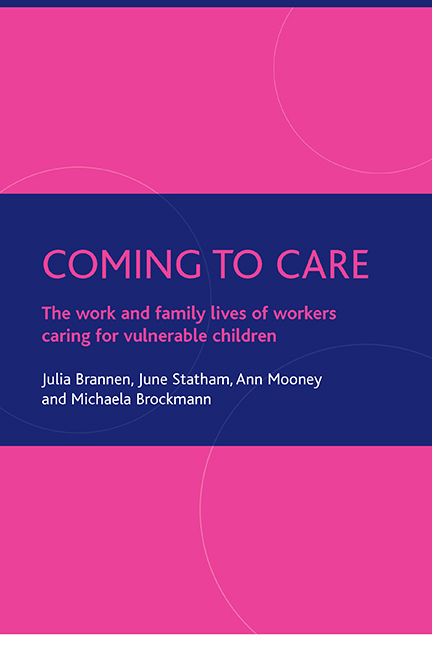Book contents
- Frontmatter
- Contents
- List of tables and boxes
- Acknowledgements
- one Setting the scene
- two The study
- three The origins of a care ethic in care workers’ childhoods
- four Entering care work with vulnerable children
- five Care workers’ careers and identities: change and continuity
- six What do vulnerable children need? Understandings of care
- seven Experiences of care work
- eight Leavers, movers and stayers
- nine Managing care work and family life
- ten Conclusions and policy implications
- Appendix: Boxes and additional tables
- References
- Index
nine - Managing care work and family life
Published online by Cambridge University Press: 15 September 2022
- Frontmatter
- Contents
- List of tables and boxes
- Acknowledgements
- one Setting the scene
- two The study
- three The origins of a care ethic in care workers’ childhoods
- four Entering care work with vulnerable children
- five Care workers’ careers and identities: change and continuity
- six What do vulnerable children need? Understandings of care
- seven Experiences of care work
- eight Leavers, movers and stayers
- nine Managing care work and family life
- ten Conclusions and policy implications
- Appendix: Boxes and additional tables
- References
- Index
Summary
Introduction
An important part of the jigsaw in understanding childcare workers’ lives remains, namely how as parents and family members childcare workers managed to combine their work and other care responsibilities – how they connected their public and private worlds, not only over time but also on a daily basis. For these workers, caring was an intrinsic part of both work and family life, a condition with the potential to add to tensions and overload typically experienced by those juggling work and family responsibilities. If more people are to be attracted to and retained in this type of work, a consideration of work–family policies and practice may point to some of the issues that need to be addressed.
Much of the recent British literature has focused upon notions of work–life balance, a concept which implies that creating some balance between work and family life is feasible and that the power to do this is vested in the individual worker. In practice, most people manage their lives as best they can by deploying whatever resources are available to them in different contexts (workplace, home, wider social networks and public policy). Whether they achieve or seek to achieve balance is arguably less important than managing to get by on a day-to-day basis. Work and family are not mutually exclusive domains. Rather, work and family life may be conceptualised as sets of ‘practices’ that actors engage in. Thereby each set of practices may cross different domains, allowing the individual to create their own ways of doing things (Morgan, 1996). Thus the conceptual emphasis moves from actors operating in discrete social domains (workplace or family setting) to how they manage their different responsibilities and life modes across domains and in the context of differential access to resources of various kinds – cultural, structural and personal.
In this endeavour, work–family boundary theory has been helpful. This explores how people negotiate the boundary between work practices and family practices and the ‘spill-over’ between these (Nippert-Eng, 1996; Campbell-Clark, 2000; Sullivan and Lewis, 2000; Brannen et al, 2001; Mauthner et al, 2001; Perrons, 2003; Reynolds et al, 2003; Brannen, 2005). Ways of negotiating work–family boundaries are not static but change over time, for example over the lifecourse as children grow up and parents and children have different needs and responsibilities.
- Type
- Chapter
- Information
- Coming to CareThe Work and Family Lives of Workers Caring for Vulnerable Children, pp. 177 - 204Publisher: Bristol University PressPrint publication year: 2007



